5.1E: Exercises
- Page ID
- 31113
Verbal
1) Draw an angle in standard position. Label the vertex, initial side, and terminal side.
- Answer
-
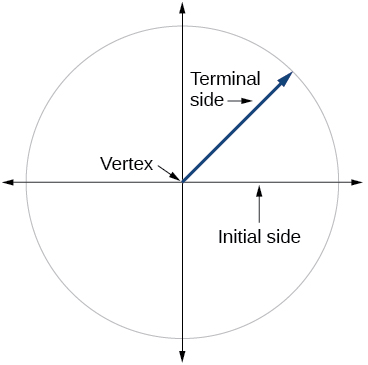
2) Explain why there are an infinite number of angles that are coterminal to a certain angle.
3) State what a positive or negative angle signifies, and explain how to draw each.
- Answer
-
Whether the angle is positive or negative determines the direction. A positive angle is drawn in the counterclockwise direction, and a negative angle is drawn in the clockwise direction.
4) How does radian measure of an angle compare to the degree measure? Include an explanation of \(1\) radian in your paragraph.
5) Explain the differences between linear speed and angular speed when describing motion along a circular path.
- Answer
-
Linear speed is a measurement found by calculating distance of an arc compared to time. Angular speed is a measurement found by calculating the angle of an arc compared to time.
Graphical
For exercises 6-21, draw an angle in standard position with the given measure.
6) \(30^{\circ}\)
7) \(300^{\circ}\)
- Answer
-
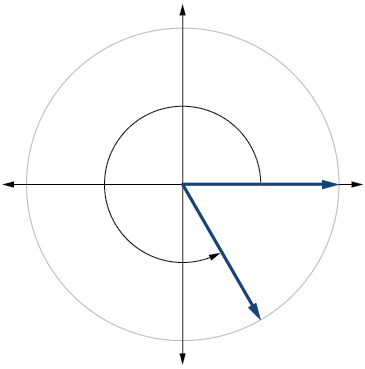
8) \(-80^{\circ}\)
9) \(135^{\circ}\)
- Answer
-
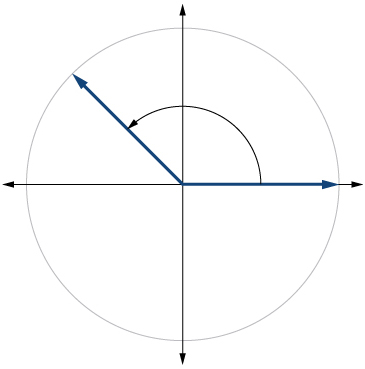
10) \(-150^{\circ}\)
11) \(\dfrac{2π}{3}\)
- Answer
-
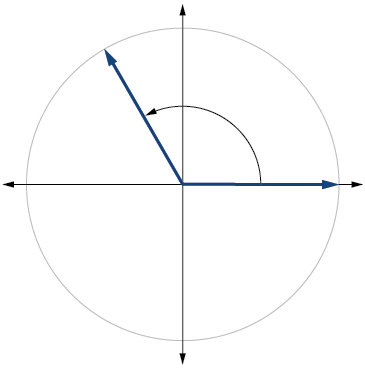
12) \(\dfrac{7π}{4}\)
13) \(\dfrac{5π}{6}\)
- Answer
-
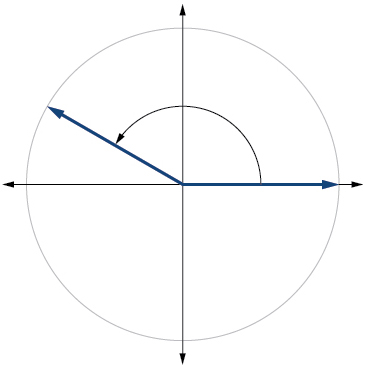
14) \(\dfrac{π}{2}\)
15) \(−\dfrac{π}{10}\)
- Answer
-
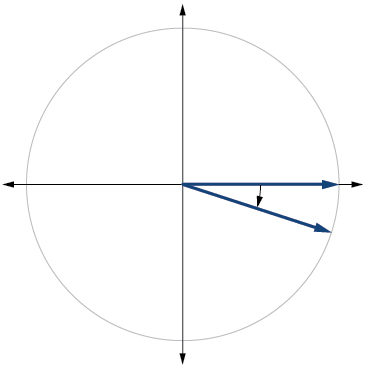
16) \(415^{\circ}\)
17) \(-120^{\circ}\)
- Answer
-
\(240^{\circ}\)
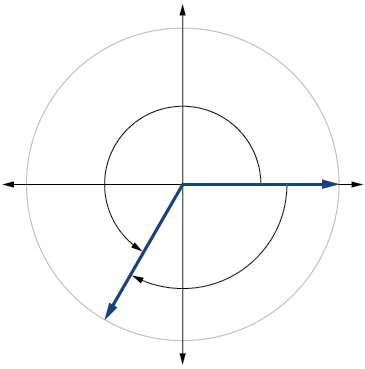
18) \(-315^{\circ}\)
19)\(\dfrac{22π}{3}\)
- Answer
-
\(\dfrac{4π}{3}\)
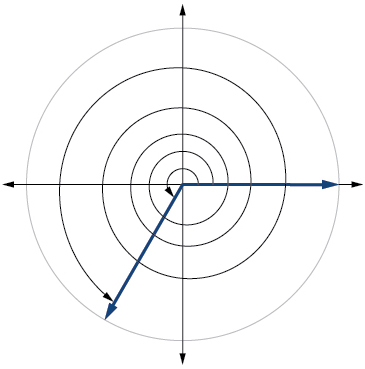
20) \(−\dfrac{π}{6}\)
21) \(−\dfrac{4π}{3}\)
- Answer
-
\(\dfrac{2π}{3}\)
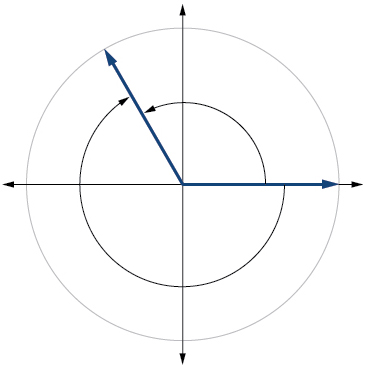
For the exercises 22-23, refer to Figure below. Round to two decimal places.
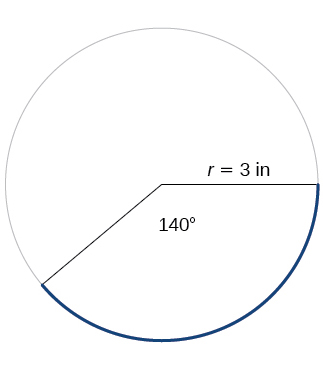
22) Find the arc length.
23) Find the area of the sector.
- Answer
-
\(\dfrac{27π}{2}≈11.00 \text{ in}^2\)
For exercises 24-25, refer to Figure below. Round to two decimal places.
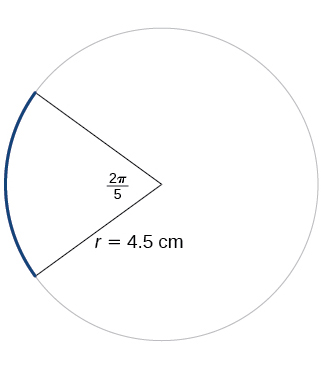
24) Find the arc length.
25) Find the area of the sector.
- Answer
-
\(\dfrac{81π}{20}≈12.72\text{ cm}^2\)
Algebraic
For exercises 26-32, convert angles in radians to degrees.
26) \(\dfrac{3π}{4}\) radians
27) \(\dfrac{π}{9}\) radians
- Answer
-
\(20^{\circ}\)
28) \(−\dfrac{5π}{4}\) radians
29) \(\dfrac{π}{3}\) radians
- Answer
-
\(60^{\circ}\)
30) \(−\dfrac{7π}{3}\) radians
31) \(−\dfrac{5π}{12}\) radians
- Answer
-
\(-75^{\circ}\)
32) \(\dfrac{11π}{6}\) radians
For exercises 33-39, convert angles in degrees to radians.
33) \(90^{\circ}\)
- Answer
-
\(\dfrac{π}{2}\) radians
34) \(100^{\circ}\)
35) \(-540^{\circ}\)
- Answer
-
\(−3π\) radians
36) \(-120^{\circ}\)
37) \(180^{\circ}\)
- Answer
-
\(π\) radians
38) \(-315^{\circ}\)
39) \(150^{\circ}\)
- Answer
-
\(\dfrac{5π}{6}\) radians
For exercises 40-45, use to given information to find the length of a circular arc. Round to two decimal places.
40) Find the length of the arc of a circle of radius \(12\) inches subtended by a central angle of \(\dfrac{π}{4}\) radians.
41) Find the length of the arc of a circle of radius \(5.02\) miles subtended by the central angle of \(\dfrac{π}{3}\).
- Answer
-
\(\dfrac{5.02π}{3}≈5.26\) miles
42) Find the length of the arc of a circle of diameter \(14\) meters subtended by the central angle of \(\dfrac{5\pi }{6}\).
43) Find the length of the arc of a circle of radius \(10\) centimeters subtended by the central angle of \(50^{\circ}\).
- Answer
-
\(\dfrac{25π}{9}≈8.73\) centimeters
44) Find the length of the arc of a circle of radius \(5\) inches subtended by the central angle of \(220^{circ}\).
45) Find the length of the arc of a circle of diameter \(12\) meters subtended by the central angle is \(63^{circ}\).
- Answer
-
\(\dfrac{21π}{10}≈6.60\) meters
For exercises 46-49, use the given information to find the area of the sector. Round to four decimal places.
46) A sector of a circle has a central angle of \(45^{\circ}\) and a radius \(6\) cm.
47) A sector of a circle has a central angle of \(30^{\circ}\) and a radius of \(20\) cm.
- Answer
-
\(104.7198\; cm^2\)
48) A sector of a circle with diameter \(10\) feet and an angle of \(\dfrac{π}{2}\) radians.
49) A sector of a circle with radius of \(0.7\) inches and an angle of \(π\) radians.
- Answer
-
\(0.7697\; in^2\)
For exercises 50-53, find the angle between \(0^{\circ}\) and \(360^{\circ}\) that is coterminal to the given angle.
50) \(-40^{\circ}\)
51) \(-110^{\circ}\)
- Answer
-
\(250^{\circ}\)
52) \(700^{\circ}\)
53) \(1400^{\circ}\)
- Answer
-
\(320^{\circ}\)
For exercises 54-57, find the angle between \(0\) and \(2\pi \) in radians that is coterminal to the given angle.
54) \(−\dfrac{π}{9}\)
55) \(\dfrac{10π}{3}\)
- Answer
-
\(\dfrac{4π}{3}\)
56) \(\dfrac{13π}{6}\)
57) \(\dfrac{44π}{9}\)
- Answer
-
\(\dfrac{8π}{9}\)
Real-World Applications
58) A truck with \(32\)-inch diameter wheels is traveling at \(60\) mi/h. Find the angular speed of the wheels in rad/min. How many revolutions per minute do the wheels make?
59) A bicycle with \(24\)-inch diameter wheels is traveling at \(15\) mi/h. Find the angular speed of the wheels in rad/min. How many revolutions per minute do the wheels make?
- Answer
-
\(1320\) rad \(210.085\) RPM
60) A wheel of radius \(8\) inches is rotating \(15^{\circ}/s\). What is the linear speed \(v\), the angular speed in RPM, and the angular speed in rad/s?
61) A wheel of radius \(14\) inches is rotating \(0.5 \text{rad/s}\). What is the linear speed \(v\), the angular speed in RPM, and the angular speed in deg/s?
- Answer
-
\(7\) in./s, \(4.77\) RPM, \(28.65\) deg/s
62) A CD has diameter of \(120\) millimeters. When playing audio, the angular speed varies to keep the linear speed constant where the disc is being read. When reading along the outer edge of the disc, the angular speed is about \(200\) RPM (revolutions per minute). Find the linear speed.
63) When being burned in a writable CD-R drive, the angular speed of a CD is often much faster than when playing audio, but the angular speed still varies to keep the linear speed constant where the disc is being written. When writing along the outer edge of the disc, the angular speed of one drive is about \(4800\) RPM (revolutions per minute). Find the linear speed if the CD has diameter of \(120\) millimeters.
- Answer
-
\(1,809,557.37 \text{ mm/min}=30.16 \text{ m/s}\)
64) A person is standing on the equator of Earth (radius \(3960\) miles). What are his linear and angular speeds?
65) Find the distance along an arc on the surface of Earth that subtends a central angle of \(5\) minutes \((1 \text{ minute}=\dfrac{1}{60} \text{ degree})\). The radius of Earth is \(3960\) miles.
- Answer
-
\(5.76\) miles
66) Find the distance along an arc on the surface of Earth that subtends a central angle of \(7\) minutes \((1 \text{ minute}=\dfrac{1}{60} \text{ degree})\). The radius of Earth is \(3960\) miles.
67) Consider a clock with an hour hand and minute hand. What is the measure of the angle the minute hand traces in \(20\) minutes?
- Answer
-
\(120°\)
Extensions
68) Two cities have the same longitude. The latitude of city A is \(9.00\) degrees north and the latitude of city B is \(30.00\) degree north. Assume the radius of the earth is \(3960\) miles. Find the distance between the two cities.
69) A city is located at \(40\) degrees north latitude. Assume the radius of the earth is \(3960\) miles and the earth rotates once every \(24\) hours. Find the linear speed of a person who resides in this city.
- Answer
-
\(794\) miles per hour
70) A city is located at \(75\) degrees north latitude. Assume the radius of the earth is \(3960\) miles and the earth rotates once every \(24\) hours. Find the linear speed of a person who resides in this city.
71) Find the linear speed of the moon if the average distance between the earth and moon is \(239,000\) miles, assuming the orbit of the moon is circular and requires about \(28\) days. Express answer in miles per hour.
- Answer
-
\(2,234\) miles per hour
72) A bicycle has wheels \(28\) inches in diameter. A tachometer determines that the wheels are rotating at \(180\) RPM (revolutions per minute). Find the speed the bicycle is traveling down the road.
73) A car travels \(3\) miles. Its tires make \(2640\) revolutions. What is the radius of a tire in inches?
- Answer
-
\(11.5\) inches
74) A wheel on a tractor has a \(24\)-inch diameter. How many revolutions does the wheel make if the tractor travels \(4\) miles?

